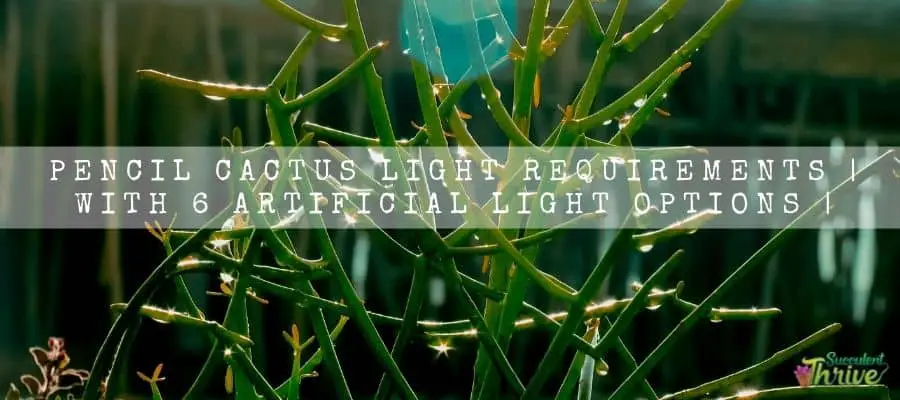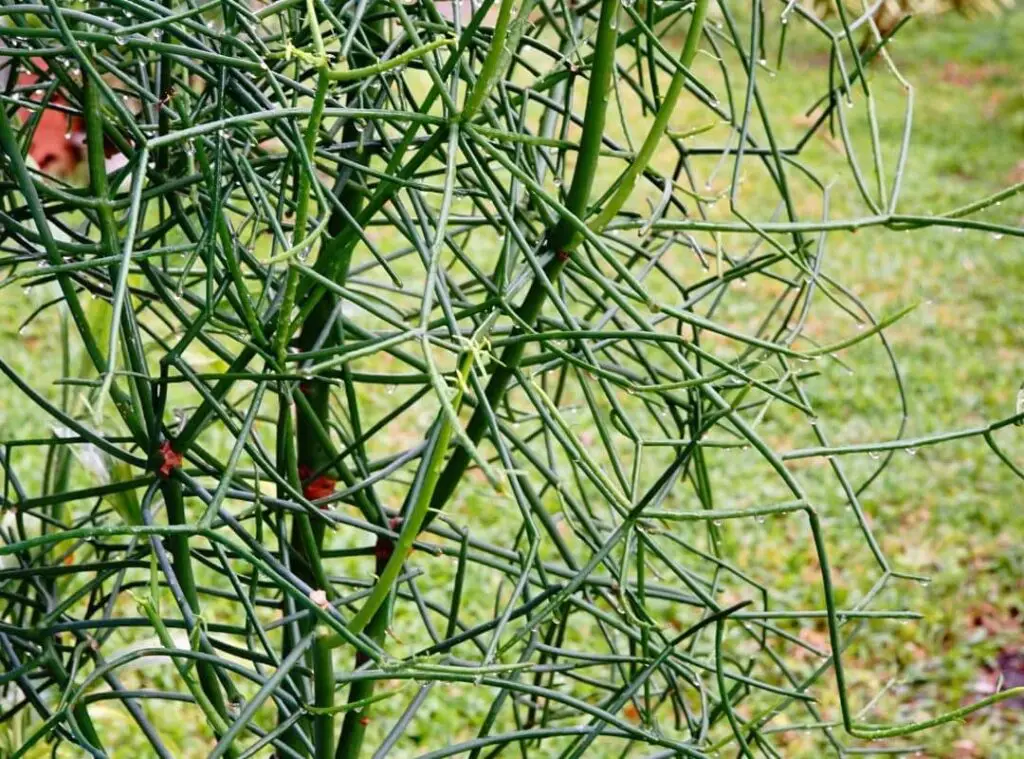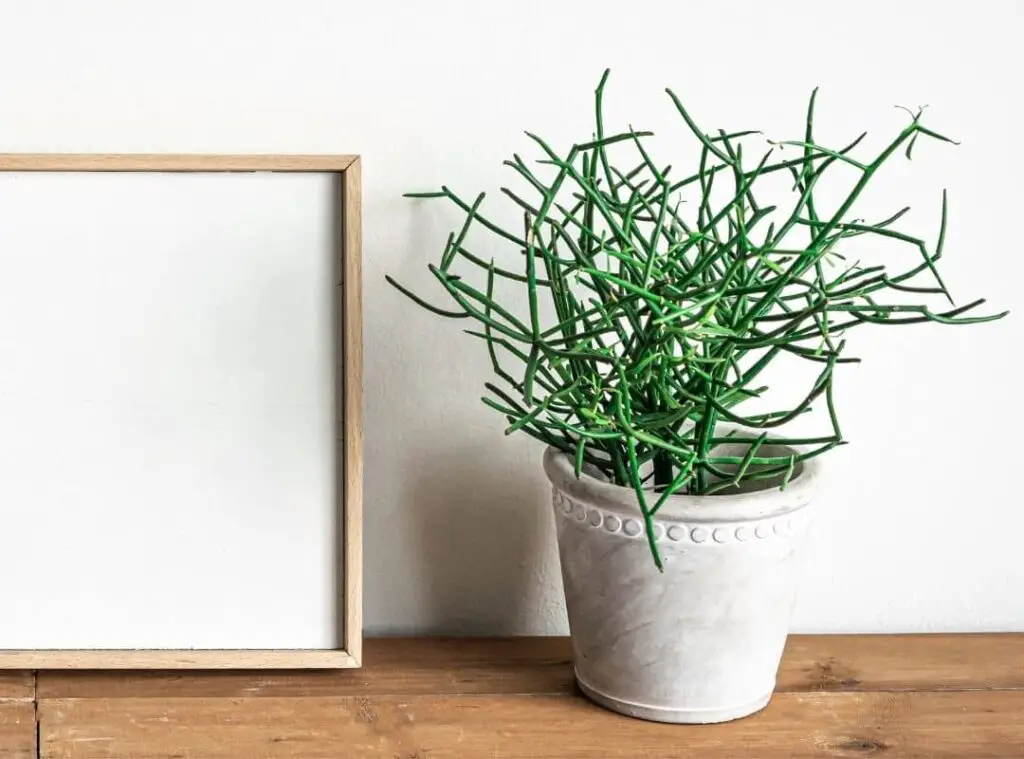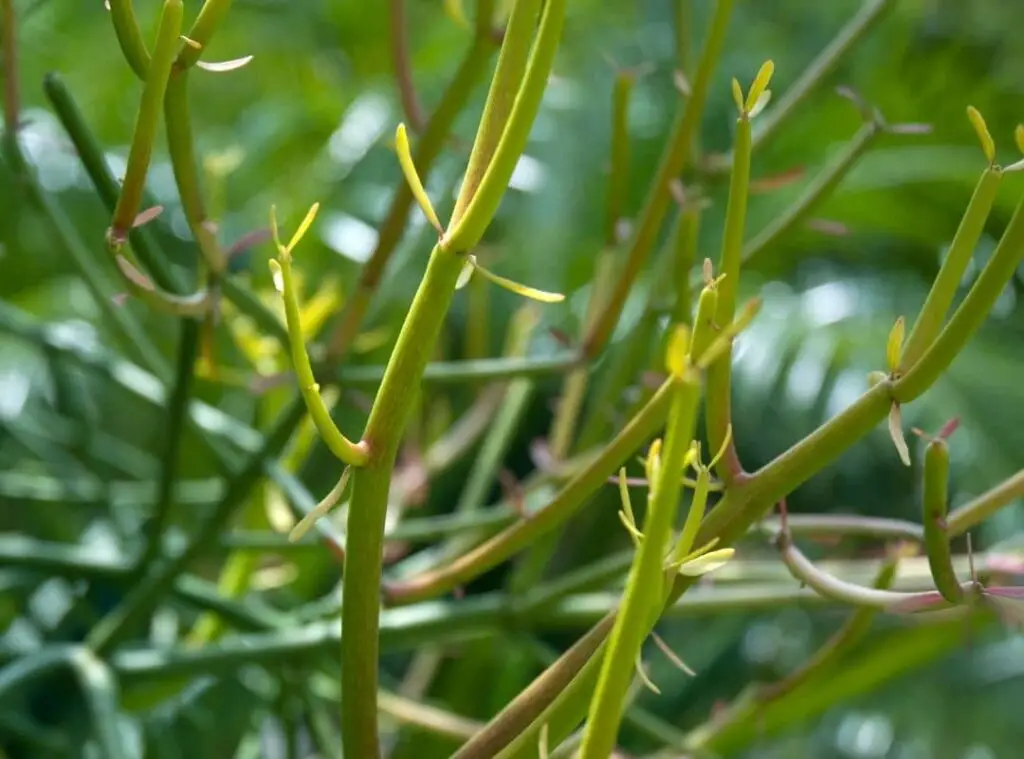Light requirements are different from one succulent to another. Therefore it is important to understand the light requirement of the plant you wish to have in your garden. In this article we are going to discuss about pencil cactus light requirements and other important facts.

How much light do pencil cacti need?
Pencil cactus would prefer to live under high levels of sunlight. They are special since they could thrive without water for prolonged periods.
They require only a little water as they are used to grow in drought conditions. Many people tend to grow them as houseplants.
Having said that, many people find it difficult to provide adequate sunlight when they grow them as indoor plants.
Since it is somewhat difficult to provide adequate sunlight for the pencil cactus, you could consider providing artificial light to fulfill its sunlight requirement.
As you keep on reading this, you could get to know how we can use those artificial lights.
When you are growing pencil cactus as indoor plants, you could place them in the brightest sunny spot at your home.
It should ideally be your bright sunny window. They do not usually thrive in low light conditions. Make sure you provide full sunlight equally.
Once you do that, they will grow to their fullest and will reward you with a fantastic aesthetically beautiful plant.
Read More: How Much Light For Snake Plants? 5 Direct Answers
Different light condition for pencil cactus
Low light
You should not grow pencil cactus under low light since they cannot thrive well in those conditions. They want full sunlight to grow well.
If they run short of sunlight, they would not grow to their best. Lack of sunlight would impact on the health and on the well being of the plant as well.
Medium light
Pencil cactus would thrive in bright medium sunlight.
High light
This is the most favorite lighting condition of the pencil cactus. They would love to grow under high levels of sunlight.
Be it indoors or outdoors, ensure that you provide high light for them to grow well. if you consider growing them outdoors, locate them in a bright sunny pot.
When it comes to growing them indoors, you should follow the same guidelines and place them somewhere where they could absorb maximum sunlight.
Best option would be to locate them near a bright sunny window when you are growing them indoors.

Artificial light for pencil cactus
Fluorescence
If your pencil cactus lacks adequate sunlight, the best is to go for artificial lights. Out of this, if you wish to provide low to moderate light, you could consider providing fluorescence lights.
You could also arrange these in small sized growing areas to medium sized growing areas as well. Not only that but also, you could stretch them to larger areas.
To elaborate further on this, if you use four 36 W or two 58-inch tubes, you could get about even spread over about 10 square feet.
This would be beneficial in an overwintering situation or for seedlings.
I would recommend not to use high intense lights for year-round growing cactus of high light plants since they will not give you promising outcomes.
If you wish to provide artificial lights for year around, I recommend a high output T5 fluorescent as they could produce better lighting levels.
In terms of cost, they would cost as much as the four-foot lights would do. Chances are that it could be sometimes even more.
They are somewhat bad efficiency wise, and they cannot produce intense light too.
You could arrange these lights only for matured pencil cactus as they would cater for the light intensity of the matured pencil cactus. As such, best is to utilize a four-foot fluorescent light for the pencil cactus.
Moreover, you could calculate the wattage that you need to provide for the pencil cactus’ optimal growth.
Literally, you need to provide 15 watts per square foot of the growing arena. As you may understand, this is a minimum number and hence you could utilize 40 watts bulbs for this purpose.
When you locate the fluorescent light, locate it about one-foot above the pencil cactus.
Incandescent
Well, when it comes to incandescent lights, they would not give you the best results. That is because they produce too much heat and insufficient light levels.
Moreover, there would be some metabolic effects, when the short wavelength infra-red light fastens the photosynthesis.
In that case, many people tend to use incandescent lights with the intention of making the other lights work better.
However, they are not very productive and efficient and instead of that you could use standard plant lights which are better than the incandescent lights.
HID (High-Intensity Discharge) Lighting
It is not worth using HID lamps as they are low powered and have a poor lifetime. Moreover, they would generate too much heat and be very low in efficiency too.
Best is to use HID lights which have a walttage of about 250W or even more. That will make them produce intense high light which could spread over a larger area.
If you use smaller lights, they will produce less lights along with shorter life. They could further loose output fast.
You cannot utilize them to cover a larger growing area also. In-fact you could use them to provide high intense light on a limited number of plants.

Metal Halide Lighting
Many people tend to use metal halide lights when they need to fulfill a high light requirement.
However nowadays, you could see many people tend to use T5HO and newest VHO tubes as they have so many advantages when compared to metal halide lights.
They have the ability to produce a small extreme intense light. Further they would be highly efficient too.
However, if we compare the lumen maintenance, lifetime, and the cost, fluorescent lights would be better than these. 125W pulse start metal halide is as efficient as a high intensity fluorescent light.
However, they would lose about 1/3 of the output in the first 5000 hours. As such, it would be better to have small size or extreme light intensity to get the best results of this.
It is common to spot people who tend to use 400w metal halides instead of fluorescent which you would commonly find.
They are convenient to use, and you may use them to light larger areas which require high light intensities.
It is quite normal to see people change these bulbs from 6-12 months even though you could use them for a few years.
When it comes to modern halide lights, they have a better durability and they do not usually lose light though they get older.
They could start faster, and chances are very low of exploding them. However, they would require a different ballast though.
If you use metal halides indoors, you will have a couple of disadvantages such as fire hazards and they could further affect the nearby clothes too.
HPS (High Pressure Sodium) Lighting
I would not recommend using HPS lamps all alone to use for these cacti to grow. If you let them grow under these, chances are that they could suffer from etiolation.
They also do not produce a good color either. You may use metal halides or a mix with them for best results. Only exception to using them all alone would be to supplement the natural sunlight.
In terms of the efficiency of the HPS light, and on the lumen output it is the most efficient light when compared to fluorescent or metal halide lights.
However, it would be a restricted spectrum. The technology which is used for HPS is not that sophisticated when compared to metal halide.
They have digital ballasts available. However, the basic lamp technology remains the same.
They could last for a longer time and they have better lumen maintenance when compared to metal halide.
Having said that they have not improved a lot though and the difference between them is very insignificant.

Light Requirement of baby cactus
Generally, you need to provide light for about four hours daily or baby cactus and that should ideally be direct sunlight.
You may place them in a bright sunny window. On another note, keep in mind that you need to rotate the baby cactus to make sure that the entire plant gets sunlight equally.
You could rotate them periodically and that will make sure that the whole plant gets sunlight equally.
Related questions
Can a pencil cactus survive light?
Pencil cactus could survive in light. They are a set of plants which usually grow in drought conditions where they are exposed to lots of sunlight and so much heat.
As such if you grow them as houseplants or as outdoor plants, make sure that you provide it with bright sunlight.
Avoid placing them under low light conditions. Instead, they would love to grow in direct sunlight.
If you grow the pencil cactus as indoor plants, the best spot for them to grow well would be closer to your bright sunny window.
On the other hand, if you grow them as outdoor plants, select the best place where they get maximum sunlight.
Can cactus grow under artificial light?
They could grow under artificial light only if you provide the correct bulbs.
Having said that, it is not easy to grow cacti under artificial lights and chances are that you could not even get the expected results as well. Many cacti types are dependent on intense light such as the full sunlight.
There could be exceptional cacti which would love to grow in even more intense sunlight than what they get from the sun.
As such you would need to use only the HID lighting as only then you could obtain the required light intensity. Only exception for that would be 100W lighting per square foot of plants.
If we consider summer lighting during daytime, it would be much better than providing light with artificial lights.
The shade in summer is also better than certain artificial lights. As such, if you are blessed with natural light, you should undoubtedly use it.
However, when you are growing them indoors, you need to ensure that you rotate the plant and provide light for the entire plant evenly.
In addition to the above, the heat the artificial light produces would also be concerning. As such you might need to place a fan to avoid overheating the plant as well as your house.

What kind of light does a cactus need?
They would prefer to have direct sunlight for about four to six hours. They are fond of growing in places where they get full bright sunlight so that they can thrive well.
How many lumens does a cactus need?
It is 2000 lumens and upwards per square foot. You could simply assume it in such a way where you have to use a 20W per square foot.
Is the LED light good for cactus?
You could use LED bulbs to grow cactus. They could produce a strong directional light which has a penetration which is good.
It does not need additional reflectors as well. What is interesting about LED is it has a long lifetime which is about 50,000 – 100,000 hours.
However there could still be certain new LEDS which could last for a shorter time as well. Moreover, light output of the LED reduces at a less rate from day one before it becomes too dim.
They also produce a heat which is quite similar to the rest of other artificial lights. However, the heat they generate from the LEDs is less radiating compared to the other artificial lights.
Should I rotate my cactus?
You should rotate your cactus periodically. That will help the cactus to obtain sunlight evenly for the whole cactus.
In case, if you fail to provide adequate sunlight for the cactus, it will make the cactus go through the etiolation condition.
Read Next: 15 Rare And Weird Looking Succulents For Your Home Garden
